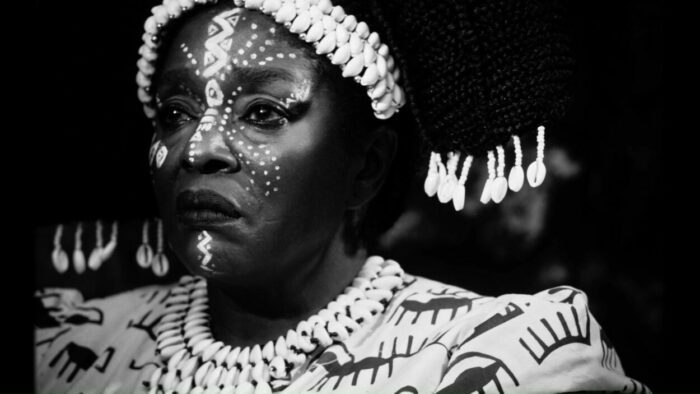Shooting in black and white these days is a risky affair. This is after decades of films which have used black and white filming to clumsily attempt to appropriate some kind of artistic credibility. More recently though, we have seen some notable examples of films doing something special with black and white film, and few have done so with such precision of purpose or such textured results than Mama Wata, one of the most celebrated titles to emerge from the Sundance Film Festival earlier this year.
White paint on black skin, in waves, dots and rows, is a centuries old element of West African iconography, it’s all over the cast of Mami Wata, with white shells in their hair and ribbons of white paint outlining their skulls. When combined with the bold, high-contrast filming of Lilis Soares’ award winning cinematography, it creates a vivid, surrealist palate out of just those two colors. The characters’ dark skins are this film’s canvas, and light is the paint adorning them. Mami Wata explores the complex conflict of faith, modernity, power and gender, telling a tale which is in microcosm, the tale of Africa itself: moving from intimate local customs and faith in communal practice, to a pressure to modernize, corruption through opportunistic Western influence and a rise in violence and patriarchy.
The village of Iyi lies on the continent’s western coast, in Benin. There, as across much of West Africa, those who fish the waters worship Mami Wata, a nautical goddess, and pay tribute to her intermediaries, the spiritual leaders and matriarchs of their communities. In Iyi, the intermediary is Mama Efe (Rita Edochie), who has been grooming her willful daughter Zinwe (Uzoamaka Aniunoh) to replace her. But Zinwe is not the only one growing impatient with Mama Efe’s impotent leadership, and when a charismatic stranger (Emeka Amakeze) washes up on their shore, the call to modernize their village begins to lead its men down a dark path.
The depth of the film’s references to West African mythology extend far beyond my grasp, or that of this review. Foreknowledge of this culture would certainly deepen one’s appreciation of the film, and it falls well short of exoticizing or diluting those elements for the comprehension of outsider audiences. But the strength of its characters, the intensity of its drama, the timelessness of the conflicts it represents, and the superficial beauty of its images should be quite sufficient to inspire the admiration of more casual viewers curious to experience a culture underrepresented on the international film stage. I’ve always found myself easily beguiled by films like Sankofa or Daughters of the Dust, weaving narratives of mysticism, African identity, femininity, resilience, and modernization in a magic realist style.

Mami Wata doesn’t approach the level of those films though. There’s little denying the potency of its imagery, or the sheer beauty of its images, and the story has the intensity and timeless tragedy worthy of folklore. But despite the beauty of the camera, the storytelling leaves somewhat to be desired. At times I had to rewind to clarify something when I was unsure what I’d just seen, and there are some elements to the story which are shall we say, extremely suspect. There are generous interpretations of these ideas, but I fear the more overt interpretation is irresistible. The celebration of womanhood is too often these days corrupted by the vilification of other genders, a dogmatic reliance on binaristic views of gender and an over-privileging of biological factors. This film’s understanding and interpretation of gender is fascinating and merits further discussion, but for now, there is one particular moment that looks unmistakably like blatant transmisandry and I’m not going to defend it.
It’s particularly unfortunate because there’s so much else about this movie that’s worth celebrating. The film has already been nominated for twelve African Movie Academy Awards, including besides its enrapturing cinematography, best supporting actress for Aniunoh, best director for C.J. Fiery Obasi and best film. Personally I’d still like to see Senegal’s Xalé take home the top prize, as it was a bolder film, formally and narratively, but Mami Wata probably has cinematography locked down, Lilis Soares does some astounding work here. The first and last thing anybody’s going to say about this film is how fantastic the use of light and darkness are throughout. I will say though, I’m surprised that Edochie was overlooked in the supporting actress category, as she has some of the most powerful moments in the film.

The film’s depiction of the conflict between ancient religions and the call to modernize is refreshingly even handed, depicting neither slant as wholly wrong, saving its ire for the opportunists who would take advantage of the conflict to seize power. Likewise the film’s ambiguous portrayal of faith, where audiences are free to interpret the film’s ending as symbolic or literal, or however they will. Perhaps the film is guilty of privileging the potency of its images over a coherent or consistent exploration of its themes, but only in that one instance do I consider that an especially damning fault. Some films exist to provoke questions rather than to provide answers and although it could well be mistaken for one of the latter, the more I think about Mami Wata the more convinced I am it’s one of the former.



